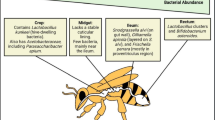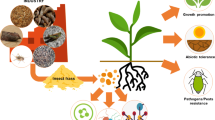Abstract
Purpose
Charred foods are generally suspected to exert health threats by providing toxicants, such as acrylamide or polycyclic aromatic hydrocarbons. Using the red flour beetle Tribolium castaneum as a model organism, we tested its survival under heat stress in response to feeding charred toast.
Methods
Survival of beetles was measured at 42 °C after a pre-feeding phase with flour enriched with increasing concentrations of charred toast. In order to assess the influence of key transcription factors for phase-I and phase-II xenobiotic metabolism, gene homologs for ahr and nrf-2, respectively, were knocked down by the use of RNA interference (RNAi).
Results
Beetles fed only charred toast died off much earlier than control beetles fed on flour, whereas beetles fed flour enriched with 5 % charred toast survived significantly longer than the control. Both, ahr and nrf-2 proved essential in order to enable the increase in survival by the feeding of 5 % charred toast. Moreover, functional loss of ahr and nrf-2 made the beetles hypersensitive versus the feeding of 100 % charred toast. Finally, at the transcriptional level, it was shown that RNAi for ahr blocked the inducing activities of charred toast on nrf-2.
Conclusions
Our studies suggest a hormetic response of the red flour beetle to feeding of charred toast that causes an increased stress resistance through the activation of ahr and nrf-2. Those adaptations, however, are saturable and accordingly the hormetic effects at increasing concentrations of the toxicants become expended.




Similar content being viewed by others
References
Mench M, Schwitzguébel JP, Schroeder P, Bert V, Gawronski S, Gupta S (2009) Assessment of successful experiments and limitations of phytotechnologies: contaminant uptake, detoxification and sequestration, and consequences for food safety. Environ Sci Pollut Res Int 16:876–900
Silkworth JB, Brown JF Jr (1996) Evaluating the impact of exposure to environmental contaminants on human health. Clin Chem 42:1345–1349
Bravo KS, Ramírez R, Durst R, Escobedo-Avellaneda ZJ, Welti-Chanes J, Sanz PD, Torres JA (2012) Formation risk of toxic and other unwanted compounds in pressure-assisted thermally processed foods. J Food Sci 77:R1–R10
Jägerstad M, Skog K (2005) Genotoxicity of heat-processed foods. Mutat Res 574:156–172
Sugimura T (2000) Nutrition and dietary carcinogens. Carcinogenesis 21:387–395
Knize MG, Salmon CP, Pais P, Felton JS (1999) Food heating and the formation of heterocyclic aromatic amine and polycyclic aromatic hydrocarbon mutagens/carcinogens. Adv Exp Med Biol 459:179–193
Grünwald S, Adam IV, Gurmai AM, Bauer L, Boll M, Wenzel U (2013) The red flour beetle Tribolium castaneum as a model to monitor food safety and functionality. Adv Biochem Eng Biotechnol 135:111–122
Grünwald S, Stellzig J, Adam IV, Weber K, Binger S, Boll M, Knorr E, Twyman RM, Vilcinskas A, Wenzel U (2013) Longevity in the red flour beetle Tribolium castaneum is enhanced by broccoli and depends on nrf-2, jnk-1 and foxo-1 homologous genes. Genes Nutr 8:439–448
Tribolium Genome Sequencing Consortium, Richards S, Gibbs RA, Weinstock GM, Brown SJ, Denell R, Beeman RW, Gibbs R, Beeman RW, Brown SJ, Bucher G et al (2008) The genome of the model beetle and pest Tribolium castaneum. Nature 452:949–955
Kang KW, Lee SJ, Kim SG (2005) Molecular mechanism of nrf2 activation by oxidative stress. Antioxid Redox Signal 7:1664–1673
Guyot E, Chevallier A, Barouki R, Coumoul X (2013) The AhR twist: ligand-dependent AhR signaling and pharmaco-toxicological implications. Drug Discov Today 18:479–486
Denison MS, Soshilov AA, He G, DeGroot DE, Zhao B (2011) Exactly the same but different: promiscuity and diversity in the molecular mechanisms of action of the aryl hydrocarbon (dioxin) receptor. Toxicol Sci 124:1–22
Burczynski ME, Penning TM (2000) Genotoxic polycyclic aromatic hydrocarbon ortho-quinones generated by aldo-keto reductases induce CYP1A1 via nuclear translocation of the aryl hydrocarbon receptor. Cancer Res 60:908–915
Miao W, Hu L, Scrivens PJ, Batist G (2005) Transcriptional regulation of NF-E2 p45-related factor (NRF2) expression by the aryl hydrocarbon receptor-xenobiotic response element signaling pathway: direct cross-talk between phase I and II drug-metabolizing enzymes. J Biol Chem 280:20340–20348
Kalthoff S, Ehmer U, Freiberg N, Manns MP, Strassburg CP (2010) Interaction between oxidative stress sensor Nrf2 and xenobiotic-activated aryl hydrocarbon receptor in the regulation of the human phase II detoxifying UDP-glucuronosyltransferase 1A10. J Biol Chem 285:5993–6002
Altincicek B, Knorr E, Vilcinskas A (2008) Beetle immunity: identification of immune-inducible genes from the model insect Tribolium castaneum. Dev Comp Immunol 32:585–595
Pfaffl MW (2001) A new mathematical model for relative quantification in real-time RT-PCR. Nucleic Acids Res 92:2002–2007
Kendig EL, Le HH, Belcher SM (2010) Defining hormesis: evaluation of a complex concentration response phenomenon. Int J Toxicol 29:235–246
Mattson MP (2008) Hormesis defined. Ageing Res Rev 7:1–7
Borriello A, Bencivenga D, Caldarelli I, Tramontano A, Borgia A, Pirozzi AV, Oliva A, Della Ragione F (2013) Resveratrol and cancer treatment: is hormesis a yet unsolved matter? Curr Pharm Des 19:5384–5393
Calabrese V, Cornelius C, Dinkova-Kostova AT, Iavicoli I, Di Paola R, Koverech A, Cuzzocrea S, Rizzarelli E, Calabrese EJ (2012) Cellular stress responses, hormetic phytochemicals and vitagenes in aging and longevity. Biochim Biophys Acta 1822:753–783
Son TG, Camandola S, Mattson MP (2008) Hormetic dietary phytochemicals. Neuromolecular Med 10:236–246
Ferguson LR, Philpott M (2008) Nutrition and mutagenesis. Annu Rev Nutr 28:313–329
Omiecinski CJ, Vanden Heuvel JP, Perdew GH, Peters JM (2011) Xenobiotic metabolism, disposition, and regulation by receptors: from biochemical phenomenon to predictors of major toxicities. Toxicol Sci 1:S49–S75
Zhang M, An C, Gao Y, Leak RK, Chen J, Zhang F (2013) Emerging roles of Nrf2 and phase II antioxidant enzymes in neuroprotection. Prog Neurobiol 100:30–47
Döring B, Petzinger E (2014) Phase 0 and phase III transport in various organs: Combined concept of phases in xenobiotic transport and metabolism. Drug Metab Rev [Epub ahead of print]
Zhang Q, Pi J, Woods CG, Andersen ME (2009) Phase I to II cross-induction of xenobiotic metabolizing enzymes: a feedforward control mechanism for potential hormetic responses. Toxicol Appl Pharmacol 237:345–356
Kohle C, Bock KW (2009) Coordinate regulation of human drug-metabolizing enzymes, and conjugate transporters by the Ah receptor, pregnane × receptor and constitutive androstane receptor. Biochem Pharmacol 77:689–699
Zhang DD (2006) Mechanistic studies of the Nrf2-Keap1 signaling pathway. Drug Metab Rev 38:769–789
Calabrese V, Cornelius C, Dinkova-Kostova AT, Calabrese EJ, Mattson MP (2010) Cellular stress responses, the hormesis paradigm, and vitagenes: novel targets for therapeutic intervention in neurodegenerative disorders. Antioxid Redox Signal 13:1763–17811
Hine CM, Mitchell JR (2012) NRF2 and the phase II response in acute stress resistance induced by dietary restriction. J Clin Exp Pathol S4. pii:7329
Birringer M (2011) Hormetics: dietary triggers of an adaptive stress response. Pharm Res 28:2680–2694
Author information
Authors and Affiliations
Corresponding author
Rights and permissions
About this article
Cite this article
Grünwald, S., Niedermeier, J. & Wenzel, U. Hormesis is induced in the red flour beetle Tribolium castaneum through ingestion of charred toast. Eur J Nutr 54, 535–541 (2015). https://doi.org/10.1007/s00394-014-0734-8
Received:
Accepted:
Published:
Issue Date:
DOI: https://doi.org/10.1007/s00394-014-0734-8




